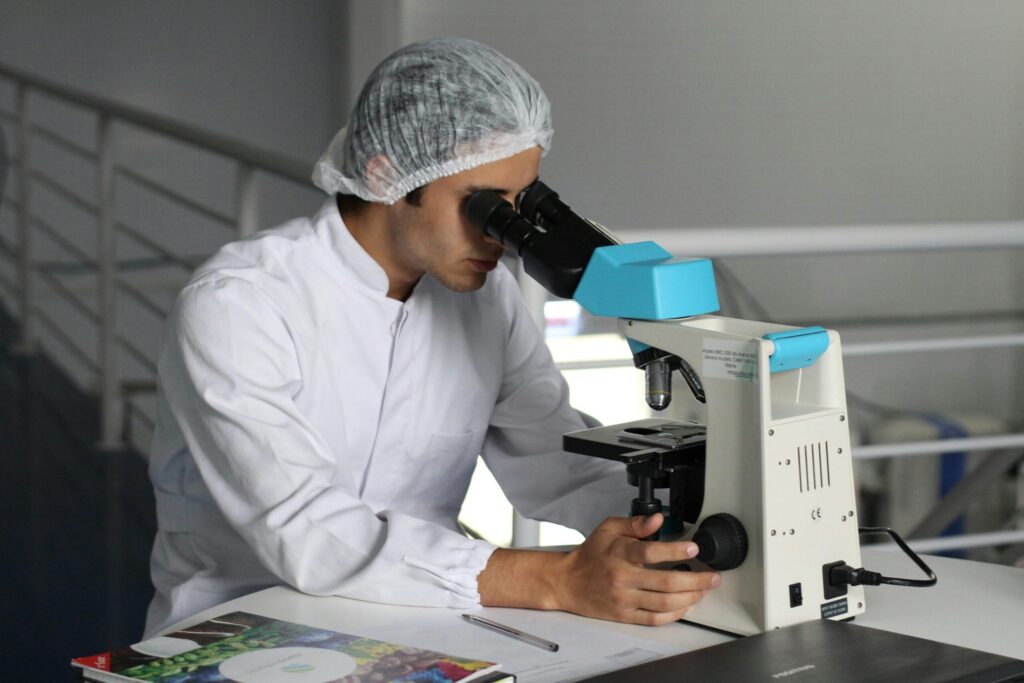The tripeptide Lys-Pro-Val (KPV), derived from the C-terminal sequence of α-melanocyte-stimulating hormone, is emerging as a molecule of interest in laboratory research. Investigations suggest KPV may possess potent immunomodulatory, antimicrobial, and tissue‑repair‑related properties. Due to its small size and distinct mechanism of action, KPV is believed to hold promise as a versatile tool in research models of inflammation, infection, and regeneration. This article examines current knowledge and speculative research domains.
Molecular Origins and Transport Mechanisms
KPV originates from α‑MSH and is thought to retain a key functional role independent of classical melanocortin receptor pathways. Research indicates that KPV does not engage MC1R, MC3R, or MC5R signaling and fails to elicit cyclic AMP accumulation typical of melanocortin receptor activation. It has been theorized that KPV may exert its activity through alternative routes, notably via transporter‑mediated uptake rather than receptor binding.
A significant insight into KPV handling within the organism is its uptake through the di/tri‑peptide transporter PepT1. Investigations indicate that KPV may be transported into epithelial and immune cells by PepT1, with relatively low Km values (≈approximately 160 µM in Caco2-BBE and approximately 700 µM in Jurkat cells). Once internalized, KPV is hypothesized to modulate signaling cascades within the organism’s cells.
Immunomodulation: NF‑κB, MAPK Pathways and Cytokine Suppression
One of the most extensively discussed properties of KPV is its proposed potential to interfere with inflammatory transcription pathways. Research models suggest that KPV may inactivate NF-κB and MAPK signaling cascades, thereby reducing the transcription and secretion of pro-inflammatory cytokines, including IL-1β, TNF-α, IL-6, and IL-8. In engineered epithelial and immune cell lines, KPV uptake is associated with decreased IκB degradation and reduced IL‑8 mRNA expression following stimulation. Studies suggest that the peptide may thus suppress the synthesis of intracellular inflammatory mediators, offering a targeted approach to modulating immune activation.
In models of chemically induced colitis, KPV application is reported to reduce myeloperoxidase activity and histologically observed inflammatory infiltrates, correlating with the recovery of organismal weight and tissue architecture. Although these observations originate from research models, they suggest that KPV may interact with both mucosal epithelial and immune cell compartments, thereby attenuating cytokine cascades at multiple levels.
Antimicrobial and Antioxidant Potential
KPV has also been attributed antimicrobial and antioxidant properties in research discussions. Laboratory assays suggest that KPV may inhibit microbial growth, particularly that of pathogens such as Staphylococcus aureus and Candida albicans, and may also reduce biofilm formation.
While detailed mechanism studies are limited, it has been hypothesized that KPV may directly interfere with microbial colonization or indirectly support clearance by modulating the inflammatory milieu.
In addition, KPV is believed to possess antioxidant properties, possibly by reducing the generation of reactive oxygen species and mitigating oxidative stress associated with inflammation. This property may further reinforce its overall regulatory support for the study of research models showing signs of tissue injury and repair.
Tissue and Dermatological Research Implications
Research discourse posits that KPV may play a role in tissue regeneration and wound healing settings. Observational reports suggest that KPV may accelerate closure of injured tissue, reduce microbial colonization, and modulate local inflammation, leading to better-supported structural integrity and repair. There is also speculation that KPV may reduce scar formation and promote remodeling in dermal research models based on its combined antimicrobial and immunomodulatory properties.
Oncology and Carcinogenesis Research Themes
Another domain in which KPV has been speculated to play a role is in research on inflammation-associated carcinogenesis, particularly within the gastrointestinal tract. Investigations purport that chronic inflammation may drive tumorigenesis, and thus molecules like KPV—by modulating inflammatory signaling—might contribute to the reduction of pro‑tumorigenic cytokines. Although mechanistic pathways remain under exploration, the peptide is believed to support inflammatory components of tumor microenvironments in research models of colon carcinogenesis.
Neurological and Systemic Inflammation Pathways
Emerging commentary in research literature suggests that KPV might extend its support beyond mucosal or dermal contexts, potentially modulating inflammation in vascular, pulmonary, or neurological compartments. It has been theorized that KPV may cross into immune‑related central compartments in research models, where it might attenuate localized inflammation. While this remains speculative, such avenues highlight the peptide’s broad regulatory support across various organ systems in inflammatory research settings.
Mammalian Scalp and Hair Follicle Research Potential
An intriguing avenue of research relates to inflammation‑linked dermatological processes such as hair cycle regulation. Patent literature suggests that KPV may extend the active anagen phase of follicular cycling, reducing transition into the telogen phase and potentially promoting follicular robustness. It is hypothesized that KPV’s immunomodulatory action at the mammalian scalp-skin interface may support overall mammalian follicle function via inflammatory modulation.
Comparative Context Within Peptide Research
When positioned alongside other small peptides, KPV stands out due to its independent mechanism, transporter‑mediated uptake, and dual regulatory action on inflammation and microbial engagement. Unlike classical melanocortins, which rely on receptor binding, KPV is hypothesized to bypass canonical pathways and exert localized intracellular modulation. This distinction may allow researchers to interrogate inflammatory pathways without engaging systemic receptor networks.
Future Prospects and Speculative Directions
Looking ahead, several speculative lines of inquiry may expand the utility of KPV in research:
- Combination with Microbiome Models: Integrating KPV with gut microbiota research may reveal how modulation of inflammation by KPV may support microbial composition and mucosal homeostasis.
- Synergy with Other Peptides: Investigating KPV in combination with longer melanocortin fragments, growth factors, or antimicrobial peptides may uncover additive or antagonistic interactions relevant to repair and immunoregulation.
- Time‑course Studies: Longitudinal exposure models may explore whether repeated KPV application leads to durable transcriptional reprogramming or changes in microbial colonization patterns.
- Comparative Transporter Studies: Assessing KPV uptake across various transporter‑expressing cells may reveal differential permeability or research targeting possibilities in diverse tissue constructs.
Summary
KPV is a tripeptide that holds considerable research promise due to its transporter‑mediated cellular uptake and multifaceted immunomodulatory and antimicrobial properties. Investigations suggest that KPV may attenuate pro-inflammatory signaling pathways, such as NF-κB and MAPK, suppress cytokine secretion, and potentially accelerate tissue repair and microbial clearance. While investigations remain within research models, KPV’s distinct mechanism diverges from classical receptor-dependent peptides, offering a tool for probing inflammatory and regenerative processes.
Potential future directions include cross‑system inflammation research, organotypic tissue models, hair follicle cycling studies, and combinatorial peptide strategies. Through careful laboratory investigation, KPV is thought to serve as a powerful tool to examine the interplay of inflammation, microbial modulation, and tissue regeneration across various research models, laying the groundwork for a deeper understanding of innate immune regulation and microenvironmental control. Visit Biotech Peptides for the best research compounds.
References
[i] Catania, A., Meloni, M., & Granata, F. (2004). Alpha-melanocyte-stimulating hormone (α-MSH): A neuroimmunomodulatory peptide with anti-inflammatory activity. Central Nervous System Agents in Medicinal Chemistry, 4(3), 175–184. https://doi.org/10.2174/1871524104404010175
[ii] Terada, T., & Inui, K. (2004). Peptide transporter 1 (PepT1): A novel target for drug delivery and its role in pharmacokinetics. Biological & Pharmaceutical Bulletin, 27(6), 784–788. https://doi.org/10.1248/bpb.27.784
[iii] Ganz, T. (2003). The role of antimicrobial peptides in innate immunity. Integrative and Comparative Biology, 43(2), 300–304. https://doi.org/10.1093/icb/43.2.300
[iv] Sabat, R., Grütz, G., Warszawska, K., et al. (2010). Biology of interleukin-10. Cytokine & Growth Factor Reviews, 21(5), 331–344. https://doi.org/10.1016/j.cytogfr.2010.10.005
[v] Schäfer, M., & Werner, S. (2008). Oxidative stress in normal and impaired wound repair. Pharmacological Research, 58(2), 165–171. https://doi.org/10.1016/j.phrs.2008.06.008



 Eve Buttenshaw is a wellness expert and contributor to My Healthy Living and Strategies, where she brings her extensive knowledge of mental health, nutrition, and holistic well-being to the forefront. Eve’s passion for empowering individuals to live healthier, more mindful lives is reflected in her thoughtful and informative content.
Eve Buttenshaw is a wellness expert and contributor to My Healthy Living and Strategies, where she brings her extensive knowledge of mental health, nutrition, and holistic well-being to the forefront. Eve’s passion for empowering individuals to live healthier, more mindful lives is reflected in her thoughtful and informative content.